 Bundesmarine, Type 123. Built 1992-96, in service.
Bundesmarine, Type 123. Built 1992-96, in service.F215-218 Brandenburg, Schleswig-Holstein, Bayern, Mecklenburg-Vorpommern
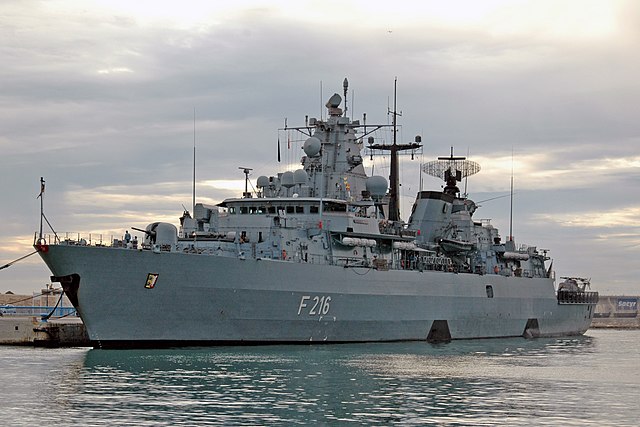
The F123 Brandenburg class were four frigates ordered in the cold war for the Bundesmarine in June 1989, as the Berlin Wall was about to fall. They were completed and commissioned between 1994 and 1996. They had been planned to replace the 1960s Hamburg-class destroyers. Their design reflected decades of technological advancaments and new concepts. They were tasked to carry out anti-submarine warfare (ASW) but with still strong capabilities for local anti-ship and anti-air defenses as well as squadron command and and gunnery shore operations. Todat with the following 2000s F124 Sachsen-class they constitute the core of today’s Bundesmarine. #bundesmarine #germannavy #frigates #coldwar #brandenburg
Although a bit off-topic since the lead ship was completed well after the end of the cold war, the Brandenburg class frigates were planned and studied in the 1980s, as the last Bremen class were entering service. They were succeeded themselves by the derived Sachsen class (Sachsen, Hamburg, Hessen launched 2001-2003) and the actual Baden-Württemberg class (Baden-Württemberg, Nordrhein-Westfalen, Sachsen-Anhalt, Rheinland-Pfalz 2013-2017), very different.
The Type F123 frigates were ordered by the German Navy in June 1989, the last being commissioned in 1996 to replace the 1960s Hamburg-class destroyers. They were mostly tailored for ASW warfare, with a residual anti-aircraft role, while gearing towards tactical command notably for surface-to-surface operations. The next Sachsen were suppose to replace the first batch of Bremen class. Today, all these four frigates are the bedrock of the Bundesmarine.
Development
In 1985, replacement for the Hamburg class (completely obsolete) was overdue. Indeed the latter were a coppromise of tonnage due to postwar limitations and ended as ASW guns armed overloaded vessels with a flush deck hull. They had been modernized, but in 1985 their lack of adaptability (they were at the limit of stability from the start) meant they were of dubious value. The Köln class frigates shared the same issues. This was solved by the Bremen class Frogates, inspired by the Dutch Kortenaer or “standard frigates”.

Baltic Sea (June 10, 2008)– The German frigate FGS Bayern (F 217) approaches the guided missile cruiser USS Gettysburg (CG 64) during an exercise for Baltic Operations (BALTOPS). BALTOPS is an annual international exercise involving 13 countries. U.S. Navy photo by Mass Communication Specialist Second Class Mike Banzhaf. Image released by LT Mark Jones, PAO CVN 65.
Blohm + Voss was contracted to create not a destroyer, but a large and versatile frigate from a clean-sheet, in 1989. So there was no DNA from Bremen class in it. Bremer Vulkan also competed but proposed a new modernized version of the Bremen, which was not retained. Blohm + Voss and Bremer Vulkan teamed and later presented the F123 as a joint programme. This was a first on the indutrial standpoint, and generated controversy.
The new class just a bit larger than the Bremen class, longer mostly, and with a bit more beam. Automation was even pushed further and enabled to get a smaller crew, but not as much as in following classes. The hull design was slanted, recalled MEKO class frigates built all along for export with success by Blohm and Voss. This design was presented to incorporate early stealth features, although not at the scale of the French Lafayette class.
They were radically different as expected to the four Hamburg-class destroyers designed for the North Sea and North Atlantic but lacking now standard assets such as an on-board helicopter and modern gas turbines and combined propulsions. The option of simply ordering a variant of the Bremen class modified with new systems from its lead contractor was not retained as Blohm + Voss’s MEKO frigates were a purely national design that had room for expansion. This, the joint F123 design offered to the German Navy was on paper, the best of both worlds. Vulkan director Friedrich Hennemann felt that Blohm + Voss later had illegitimately presented the jointly developed design as their own, sparking constroversy and an industrial dispute over tighlty protected patents.
The design was approved in 1991 and funds voted by the Bundestah for a first test ship FY1992. By that time, the USSR was no longer there as a threat and all three branches were about to be severely reduced. The lead ship, Brandenburg, was laid down in Hamburg in February 1992, launched on 28 August the same year but commissioned in October 1994. This showed how much has changed in complexity ad in the past, completion time from launch were much faster than hull construction. The new Brandenburg were indeed much more ambitious and complex ships, still designed with a scenario against the Soviet Navy in the Noerth sea and North Atlantic. The last ship, Mecklenburg-Vorpommern, was commissioned in December 1996.
The new class also resurrected named sported by former Imperial Navy’s ironclads. The Brandenburg (1892) were in fact, 100 years ago, the first German pre-dreadnoughts, whereas Bayern was the last wartme dreadnought, and Schleswig-Holstein the last pre-dreadnought still active in 1939-44. There were of course political motives behind these naming choices, as the lander concerned could be financially contributing and more closely involved in the new ships, with already many CMEs being suppliers of the four yarrds in charge of the construction:
In addition to the Brandenburg class (F123), frigates of the Sachsen and Baden-Württemberg classes are also in service with the German Navy, along with other warships. Blohm + Voss AG, Hamburg (lead ship, Brandenburg) Howaldtswerke-Deutsche Werft AG, Kiel for Schleswig-Holstein, Thyssen Nordseewerke GmbH, Emden for Bayern and Bremer Vulkan for Mecklenburg-Vorpommern. Having these four separate yards working at the same time enabled the delivery of all four frigates in record time between 1995 and 1996.
Back to the early cold war, the GIUK Gap and Norwegian Sea concrned NATO in 1957 which led the training Operation Strikeback. With 200 warships, 650 aircraft and 75,000 personnel this was largest peacetime naval operation and the largest fleet since World War II. The simulation stretched from Norway to Turkey. There were also the REFORGER convoys, with over 200 merchant ships including the Queen Mary and Ile de France marked as target ships. USS Seawolf and Nautilus were involved on the “enemy” side, 8,000 marines landed in the Dardanelles (Operation Deep Water) and NATO occupied Norwegian bases with simulated tactical nuclear weapons.
The Warsaw Pact in 1970 created in response Exercise Okean, largest naval exercise on its side with over 200 ships and several hundred aircraft between the Baltic Sea, Barents Sea, Atlantic, Mediterranean, North Sea and Pacific, even so far as the Philippine Sea and Sea of Japan. In 1981, amphibious warfare was practiced together with Syria and in 1983, and the USSR also practiced convoys defence with 40 Soviet merchant ships.
The ships of the Brandenburg class were designed in this context, to conduct REFORGER convoys missioned across the Atlantic in cooridnation with other NATO countrie’s fleets. It was planned that the Soviet naval aviation would try to sink these convoys with supersonic TU-26 (TU-22M) backfire attacks coordinated with submarine’s strikes. The bundesmarine’s staff concluded its escorts needed more emphasis on combined air and submarine defense capable of tacking possible saturation attacks. The EAGIS system was amtready well known, and so a comparable system was desirable, if practicable, short of purchasing the US system istelf. The main focus of the Brandenburg class was on ASW though, and looked more towards the Spruance class. Installing a towed sonar to listen passively in the low frequency range and form a bistatic arrangement with Class 212A submarines in the medium frequency range were though for example to improve situational awareness.
The Mk. 41 Mod. 4 vertical launch system installed was planned to fire also anti-submarine missiles such as the RUM-139 VL-ASROC, but it was not purchased by the Bundeswehr. The air defence bubble was to be significantly improved by upgrading the VLS from 16 to 32 cells, a critic (now classic and shared by the Sachsen) of Bundesmarine ships being underarmed. The Mk. 41 Mod. 4 was thought able to fire the Standard Missile 2 and ESSM, guided to the target by STIR. The Bundeswehr decided to replace the NSSM with longer-range ESSM from 2014 to keep pace with the Bremen-class frigates upgraded though.
The Exocet MM38 anti-ship missiles were also present from the start, but arrived at their useful service life in 2015. The RGM-84 Harpoon anti-ship missil was planned for replacement. Though, all along, air defence coordination was greatly helped by the long-range SM-2 guided missiles and latest 3D radar technology and the TASS-6-3 towed sonar, shared by the Sachsen-class frigates.
Design of the class
Hull and general design
The Brandenburg class were larger vessels than the Bremen class, at 3,600 tons (4,490 t full load) versus 3,680t standard/3900 tonnes FL.
They were longer at 138.85 m (455 ft 7 in) versus 128 m (10 m increase) while having a moderately large beam a 16.7 m (54 ft 9 in) versus 14,60 m.
Draught was only 4.35 m (14 ft 3 in) but 6.3 m (20 ft 8 in) over sonar versus 6,50 m for the Bremen.
The hull was segmented longitudinally with three faces in order to give some radar protection.
They had a relatively low silhouette, low bridge, two slanted funnels side by side (classic MEKO style) and three masts, two with mass structures.
The crew comprised 236 versus 218 in peacetime on the Bremen class, desprite extra automation. See also the radar and passive protection measures below.
In short they innovated with six double-walled bulkheads, two internal 1.2m-square box girders (outer edge of the upper deck) and a centerline 1.5 × 0.6m box girder for strength.
See also and these explanations.
Powerplant
The Brandenburg class relied on combined diesel or gas propulsion system with two MTU diesel engines, two General Electric LM2500 gas turbines for a total installed power of 38 megawatts (51,000 hp), to speed of 29+ knots (54 km/h; 33 mph).
The propulsion system being a CODOG drive combines a single 19,000 kW gas turbine LM 2500 SA-ML from General Electric and one MTU 20V 956 TB92 propulsion diesel engine rated 3,820 kW and acting on a gearbox from which a shaft with a controllable pitch propeller extends. Total output is 38,000 kW is available from both gas turbines.
An hydrodynamic clutch connects the diesel engine to the stationary gearbox. Diesel power is transmitted into a Renk gearbox BGS 178 designed as a simple reduction and summing gear. The diesel engine and gas turbine combo could easily change operation via automatic overrunning clutches, so to alternately drive the ship. The gas turbine’s nominal output is 25 MW without losses, generates a pressure ratio of 18:1 with a 16-stage compressor. After the annular combustion chamber there is a two-stage air-cooled turbine driving the compressor. The downstream six-stage power turbine is driven by hot gas, transferring its torque to the gearbox. The turbine weighs 22 t including is raft, sound capsule and elastic bearings as nois reduction measures. Its consumption is about 0.242 kg/kWh. The summing gearbox transfer this power to a Sulzer Escher Wyss variable pitch propeller.
The acoustic signature was reduced by its double-elastic bearings and sound capsule inspire by submarine’s own rafting systems. Between shafts and behind the diesels are two more backup Deutz MWM TBD-602-V16K diesels rated each for 750 kW, for all cold engines power generation on board. In normal combat use etrxa power is obtained by two more in front of the gas turbines. The Brandenburg had oil bunkerage for 4,000 nmi (7,400 km; 4,600 mi) at 18 knots (33 km/h; 21 mph).
Armament

The primary goal was not to intercept and destroy soviet bombers at long range (which would have imposed a much larger and heavier SAM system) but to defen the ship and the fleet around from anti-ship missiles and closing aircraft. This was ensured by two Mark 41 vertical launching system (VLS) modules unlike classic canister launcgers. The VLS have 8 cells each, 16 total located in front of the bridge. They fires the 16 NATO Sea Sparrow missiles and more recently the Sea Sparrow-derived ESSM (range 50 km). Four ESSM could be stored in a single cell, sharing space with two additional Mk 41 modules, only in wartime.
For close range, two fast reaction Mark 49 rolling airframe missile (RAM) launchers with 21 missiles each are located fore and aft.
This is completed by two twin canisters with Exocet block III missiles, later replaced by eight Harpoon anti-ship missiles (2×4 armoured canisters), located between main mast and funnels.
The primary ASW suite are the Mark 46 torpedoes carried by Sea Lynx helicopters. They also can be launched by the ship itself at closer ranges, from two twin launchers located close to the funnels.
Like the Bremen class they had the same, single OTO Melara 76 mm compact naval gun located forward of the RAM launcher. To deal with asymetric threats, the ships also have two Rh-202 autocannons, later replaced by MLG27 remote system and four machine guns.
Overall for 5000t frigates this was considered average, but there again, they were compared to the French contemporary Lafayette class, which were not that better armed but offered a smaller radar signature.
OTO-Melara 76/62 Compatto
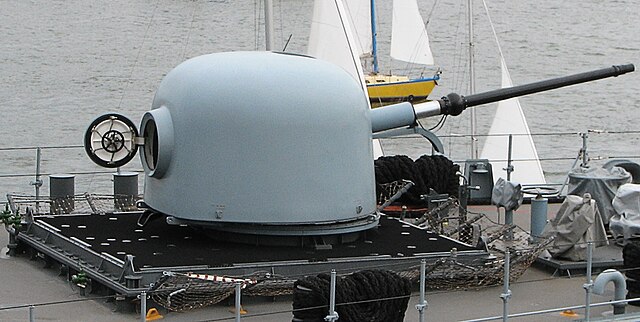
Single OTO-Melara 76 mm dual-purpose gun forward. Rounded cupola and rate of fire of 85 rounds per minute.
Rounds: 76×636mmR 12.5 kilograms (28 lb) oa, 6.3 kilograms (14 lb) shell alone +2.35 kilograms (5.2 lb) propellant
This 76.2 mm (3.00 in) elevated at −15°/+85° at 35°/s and 360° traverse at 60°/s.
Muzzle velocity was 915 m/s (3,000 ft/s), max range with the HE-PFF: 16,000 m
There were 80 ready rounds.
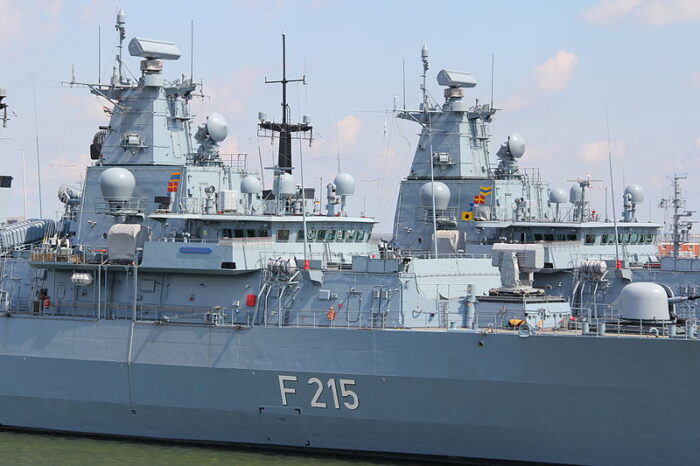
Brandenburg showing her forward hull, OTO Melera gun, RAM launcher and forward VLS. Note it’s mounted quite high over the deck to give extra room for possible future upgrades with longer missiles.
NSSM (RIM-7M Sea Sparrow)
Primary asset: Sixteen Sea Sparrow SAM, short range (like the Bremen). The original RIM-7M was capable to hit a target as low as 8 metres (26 ft), so able to destroy sea-skimming missiles such the Exocet.
Mass 510 lb (230 kg), Length 12 ft (3.7 m) x 8 in (20 cm), wingspan 3 ft 4 in (1.02 m).
Carries a 90 lb (41 kg) annular blast fragmentation warhead with proximity fuze and expanding rod, 27 ft (8.2 m) kill radius.
It was powered by a Hercules MK-58 solid-propellant rocket motor for 4,256 km/h (2,645 mph) at max 10 nmi (19 km).
ESSM (RIM-162 Evolved Sea Sparrow)
Available from 2004 and gradually replacing the RIM-7 or NSSM. Capabilities similar to the Standard SM-2.
Dimensions: 3,66 m x 254 mm diameter, 280 kg
Carries a 39 kg fragmentation warhead
Powerplant: solid-fuel engine
Mach 4, range 50 km
Target detection: semi-active radar targeting
SSM-38 Exocet
Initially two twin launchers were installed on the Brandenburg class, and these were “legacy” missiles acquired in the early 1980s, capable of only 42 km. But they were only replaced by the Harpoon in 2015.
RGM-84A Harpoon SSM
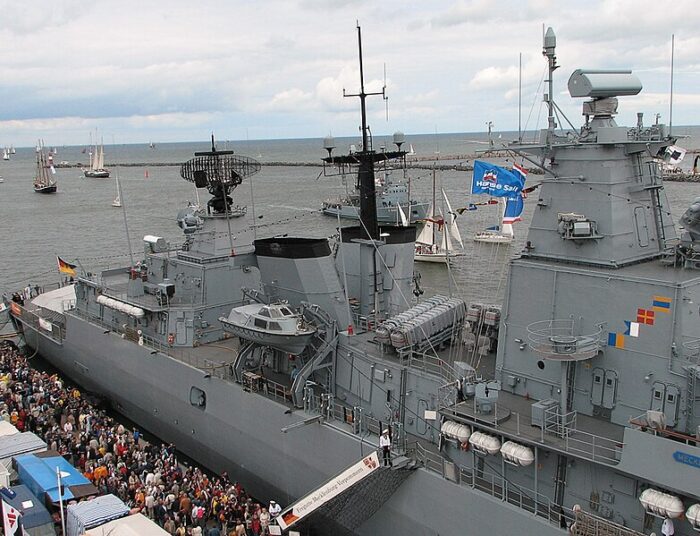
Mecklenburg-Vorpommern showing her amidships section, two 27mm on the bridge’s wings, and the funnels, and Harpoon canisters.
Two quadruple Harpoon anti-ship missile launchers. Already used by the Kortenaer and upgraded Bremen class. This “classic” had a much longer range than the Exocet and bigger payload.
691 kg, 3,8 m x 0,34 m, carrying a 221 kg warhead.
Teledyne CAE J402 turbojet/solid propellant booster for 600 lbf (2,700 N): 537 mph (864 km/h; 240 m/s; Mach 0.71)
75 nmi (139 km), Guidance: final run with active radar.
324 mm TTs
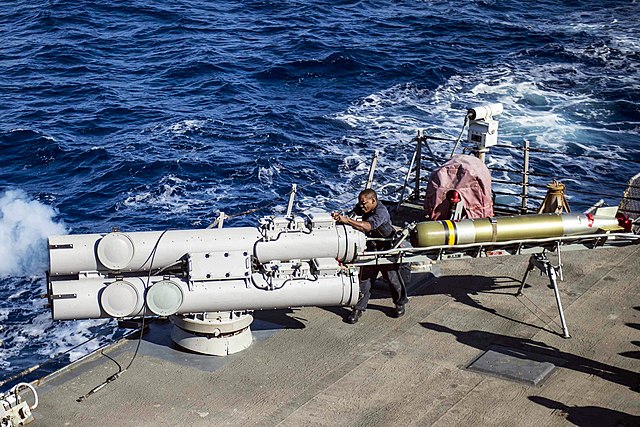
Antisubmarine warfare comprised two Mark 32 324-mm twin torpedo launchers and height DM4A1 or Mark 46 torpedo in reserve, plus the helicopters. Same systems as the USN, using Mark 46 torpedoes which had a range of 12,000 yd (11,000 m), max depht down to 1,200 ft (370 m) at 40 knots (74 km/h; 46 mph) and using active or passive/active acoustic homing. Once dropped they could stay long enough to acquire their target ans stick to it, whatever its evolution.
Mauser MLG27
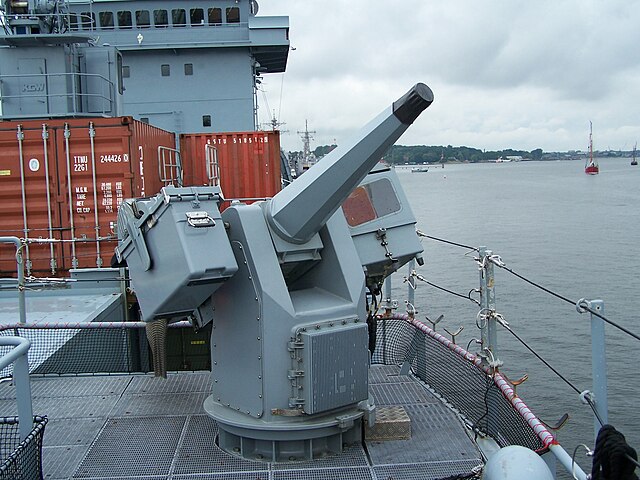
The initial Rheinmetall 20 mm Rh 202 giing back to the 1970s were replaced by two Mauser MLG27 27 mm autocannons for close in AA defence were located on the bridge’s shoulders. It originates in the Panavia Tornado, Alpha Jet, JAS 39 Gripen and Eurofighter Typhoon as primary cannons. Rheinmetall thus ddveloped remote-controlled naval versions, the MN 27 GS and the MLG 27, both fully automatic naval guns with 99 MLG 27s ordered by the Bundesmarine over the years. It used pyrotechnic cocking charges to cycle the action and fires mine shells but also a range of AP, HE, Frag, Frap, HESH rounds.
Type: single-barrel, five chamber revolver cannon, breech-cylinder, revolver operation
Caliber: 27 mm × 145 (1.063 in)
Length: 2.31 m (7 ft 7 in)
Weight (complete): 100 kg (220 lb)
Rate of fire: 1,000-1,700 rpm selectable (+/− 100 rpm)
Muzzle velocity: 1,100 m/s (3,600 ft/s), c157,300 Joules
Projectile weight: 260 g (9.2 oz)
RIM-116 RAM RALS CIWS
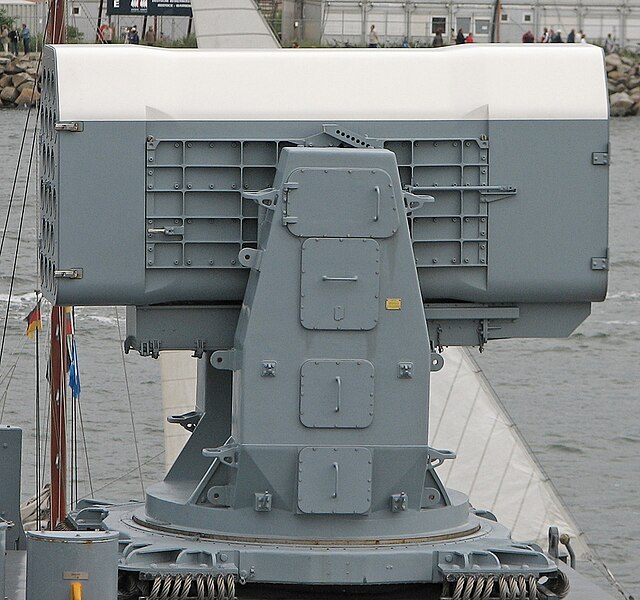
The ships receives two MK 49 missile launcher, 21 RAM each like the upgraded Bremens. RALS was developed to enable the RIM-116 A-1 guided missile to be used from ships and boats that did not have enough space to integrate the Mk 49 launcher. The launcher was designed by RAM-System GmbH in Ottobrunn, Telefunken Systemtechnik GmbH in Ulm and Per Udsen Co. Aircraft Industry, Grenaa, Denmark:
Elevation range: −25° to + 85°, traverse: ±175°
Power supply: 115 and 400 V, max. 25 KVA
Weight: 3,8 tons
The missiles are the same though, 73,5 kg, Mach 3, 10 km range guided by Passive Radar, IR and UV.
Sensors
Originally, the Brandenburg class did not have any sensor fusion but track fusion provided by the SATIR-III guidance system with AN/UYK-43 and 14 consoles from Atlas Elektronik, fitted with the Norden Track Management System (TMS). Data processing was programmed in Ada. In 1997, SATCOM terminals of the type SCOT 3 (Matra Marconi) were retrofitted and took their place in the operations center. In order to maintain contact with submerged submarines, the class is provided an underwater telephone Honeywell-ELAC UT 2000. The torpedo consoles were cannibalized from the former Hamburg-class destroyers, still valid. But later a stabilized multi-sensor platform (MSP) 500 was installed.
Schleswig-Holstein and Bayern alone were equipped with the MAIGRET system from EADS to intercept enemy communications. Additional antennas are used to intercept and locate signals from 1 to 1000 MHz. They are coupled with an emitter database for quick, automatic identification. The system can scan 3,300 channels per second (V/UHF band linearly) and a billion per second in adaptive mode (frequency hopping). Direction finding is displayed on PPI or A-scan. Characteristics are statistically recorded and evaluated.
The radar suite as completed consisted of the following:
-Thales Nederland 2D air search (LW 08),
-3D multi function (SMART-S),
-Two STIR 180 fire control radars,
-Two Raytheon navigation radars.
The SMART-S tracks aerial and surface targets, fed to the STIR fire control radars illuminating these in semi-active mode for the Sea Sparrow missiles. The STIR radars are located below the SMART-S, in front of the LW 08 radars.
Thales LW 08
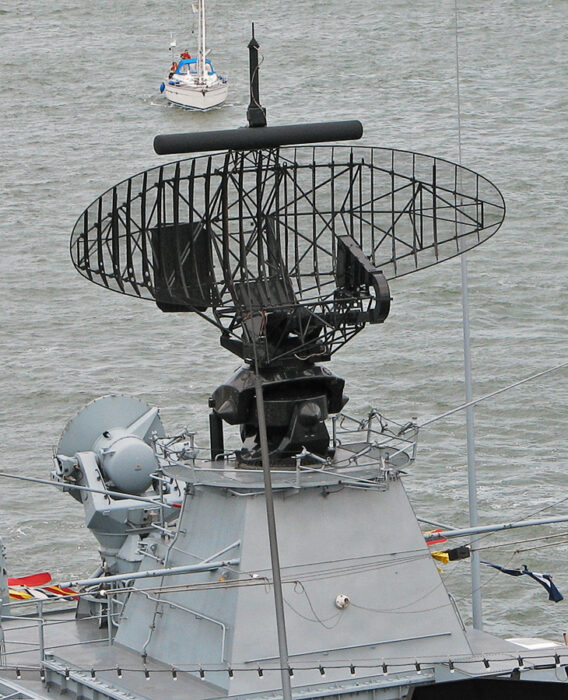
The LW 08 is an L-band radar for airspace search, 8.8 m × 7.5 m, 1.5 ton antenna (5 ton total system) stabilized from rolling and pitching. It preduced a cosecant diagram with a side angle of 2.2°. The transmission pulse is generated by compression, emitted at 150 kW and 30 dB. It is capable of 7.5 or 15 rpm with a pulse repetition rate from 1000 pps and 35 µs and 500 pps and 69 µs. Range resolution is 100 m. It als copprised a rod-shaped antenna above the reflector as secondary friend-or-foe recognition system.
The radar can track 64 tracks simultaneously but it does not have an autotracker and must be initiated manually. It wa salso criticized as very susceptible to targeted and pulsed noise interference and impulse response interference, having only six discrete frequencies between 1250 and 1350 MHz. The narrow bandwidth of only 100 MHz made it susceptible of broadband noise interference and undisturbed detection range is 261 km, up to 28.3 km and with a radar cross-section of 2 m², speeds of up to Mach 5. To reduce sea clutter, the antenna is tilted slightly backwards and so is less able to detect low-flying objects like sea- skimming missiles.
SMART-S, the Dutch/German AEGIS
Two Brandenburg-class frigates had SMART-S installed on the mast tips with STIR on a mast projection below. The FL 1800 boxes are located at the corners of the mast tip. This system from Thales Naval Nederland is a passive phased controlled rotating radar with a rectangular antenna located on the highest mast. It was developed specifically to locate low-flying Mach 3 anti-ship missiles, with a radar cross-section as small as 0.1 m², and locate missiles in a dive at 60° descent. The processing was able track up to 160 air and 40 ship simultaneously.
It worked on S-band (2–4 GHz) as a compromise between range, clutter and antenna dimensions. The system rests on a 1.2 tons, 4.8 × 2.05 m antenna rotating at 27 rpm. Peak power is 145 kW, with a transmission beam radiated by a horn antenna on a width of 23 dB. Received signals are captured by 16 horizontal strips generating 12 stacked virtual signal beams, with a 2° horizontal, 9° vertical opening angle, or 31.5 dB. This covers all elevation ranges up to 90° and the processing skips rolling and pitching.
The radar main role is to direct target assignment to the illuminator, with fixed signal suppression using a fast Fourier transformation and coherence. Transmission is done by a pulse repetition rate of 3800/s, pulse width of 0.6 µs. But it lacked friend-or-foe recognition.
STIR
The STIR 180 target illumination radar is providing a targeting beam to SSM and SAM assets on board. Missiles then can target the radar reflections and hit the target. Two STIRs are located on the second deck in front of, and below the SMART-S, behind the LW 08. The rotating/tiltable antenna weights 1.7 tons for 1.8 m. It is the most important system of surface-to-air capability, but only one target can be attacked per illuminator, so two in all combined. The STIR could also control gunfire. Its core is a Cassegrain monopulse antenna operating in X and Ku bands, sending a radar beam at 1.4° (0.3° Ku band). The magnetron generates a pulse power of 220 kW or 20 kW in the Ku band. When the target is locked, it can be tracked at up to 170°/s in azimuth, 115°/s in elevation. Pulse repetition frequency goes from 1800 pps to 3600 pps with a pulse width of 0.29 or 0.14 µs respectively.
DSQS-23BZ
For ASW there is an Atlas Elektronik DSQS-23BZ bow sonar as main asset. It was planned at first to treat low-frequency active sonars under the Franco-German LFTASS programme until France withdrew in 2000 and ended as a copy of the British Sonar 2087. Bayern received the prototype TASS 6-3 but funds were lacking to upgrade the ships (that is until 2022).
The DSQS-23BZ from Atlas Elektronik (ASO 96) is part of the ASO-90 family, with piezo-based sound transducers in polyvinyl fluoride that can swivel virtual signal beams like Active Electronically Scanned Arrays. The cylinder base is 2.5 m and and can form 32 to 64 virtual signal beams stabilized by electronic beam swiveling in conditions of 25° rolling, 8° pitching. The antenna covers frequency ranges from 2 to 11 kHz in passive mode, 6 to 9 kHz in active mode. The bandwidth of 1 kHz is used for purely passive reception. Two CW frequencies can be used during a ping in active mode. Transmission is analog though. Pulse length ranges from 5, 50, or 300 ms. The received data from CW and FM signals are processed in parallel. The CW enables to calculate the Doppler effect and determine radial speed whereas the FM profiles the target and outputs a course angle and hull length. Based on both the computer uses speed and size and classifies the contact as ship or submarine. The transmission could be Omnidirectional or with three active signal lobes and in combination of 5 ms/50 ms pulses notably to reach fire control solutions.
The integrated intercept sonar works passively under 1-100 kHz, hearing pinging of ultrasonic torpedo seekers. In 1996-1997, they were upgraded with a mine detection capability.
TAS 6-3
Originally, the low-frequency (15 Hz to 1.2 kHz) towed sonar TAS 6-3 was planned for 1997 to passively locate submarines at safety distances but intsead was adopted the Low-Frequency Towed Active Sonar towed sonar (LFTAS), a VDS that should transmit in the frequency range of 2–3 kHz, range 50 km, but also capable to work as a bistatic sonar in cooperation with the Class 212 A submarines to reach a 80 km range. The onboard CSU 90 unit evaluates the angle and time difference between the LFTAS ping and echo at the target, but it was never installed.
Sensors and processing systems:
-One Thales LW08 air search D band radar
-one Thales SMART-S air/surface surveillance F band radar
-two Thales STIR 180 fire-control radar
-two Raytheon Redpath I band navigation radar
-one STN Atlas DSQS-23BZ hull-mounted sonar
-one STN Atlas TASS 6-3 (LFTASS) towed array sonar (Bayern only)
Electronic warfare & decoys
-1 EADS FL 1800S ECM suite
-Four TKWA/MASS (Multi Ammunition Softkill System) decoy dispenser (replaced two OTO-Melara SCLAR dispensers in 2009)
Active Protection
FL 1800 S
Electronic countermeasures are provided by an EADS FL-1800S ECM suite: The FL 1800 is the Bundesmarine’s standard electronic warfare system, developed to ward off mass attacks with anti-ship missiles in the Baltic or North Sea. The system consists of four ESM boxes with two combined antenna surfaces covering a frequency range of 0.5 to 18 GHz, and ten spiral antennas for each band. There are seven computer racks below deck to determine elevation and azimuth angle and calculate out multipath reception.
To disrupt enemy radars, four additional antenna surfaces carries the electronic countermeasures for passively phased signal beams and eight traveling wave tubes in the frequency range of 7.5 to 18 GHz. Each signal beam can disrupt a single target or a radar in combination. The effective radiation power covers the entire frigate weapons’s suite cover. In addition to hardware improvements and to generate pulsed noise, the “S” variant features a distance estimation based on amplitude to fire RAM missiles in anti-radar, ship-to-air mode and destroyer either anti-ship missiles and aircraft.
TKWA/MASS decoy launchers
Called the Multi Ammunition Softkill System, it is a naval self-defence system produced by Rheinmetall, connected to on board sensors and protecting from attacks by advanced sensor-guided missiles. Each launches 7 decoys operating in all relevant wavelengths of the electromagnetic spectrum: ultraviolet, electro-optical, laser, infrared and radar. It was exported to 9 nations (130 launchers), fitted 15 different classes as of 31 March 2009, 127 launchers by 2011, 186 by 2012.
Passive Protection
With average active defences, the ships needed to be resilient in case of a hit. The Brandenburg class were structurally thought to remain afloat even after heavy damage and continue to fight if possible. But bvefore this, the key is not to be seen, ie. a drastic reduction in radar signature using B&V MEKO limited slealth shaping principle, a novelty in the Navy. The design made it possible to reduce the radar signature to just 10% of a Bremen class (F122) and there was no need to mount the Bremen class Prairie Masker system.
Structural strenght is provided by six double transverse bulkheads, three box girders acting as longitudinal bulkhad and buoyancy reserves. These box girders ran at the level of the upper deck, from the VLS to the helipad, port and starboard up to the forward section of of the hull over 80% of the ship’s length. The cross-section of the rectangular outer box girders is 1.2 m × 1.2 m, and cross-section of the middle ones is 1.5 m × 0.6 m. These additional stiffeners and cofferdams ensure gas blast and splinter cloud could expand to a limited extent in the ship, and longitudinal strength is maintained. The ship’s hull is divided into twelve large watertight compartments, four damage control areas with their its own command area. Two diesel-powered and ten electric fire pumps are distributed to provided fire extinction. The Brandenburg class solutions were adopted and improved upon for the next Sachsen class.
Air Group
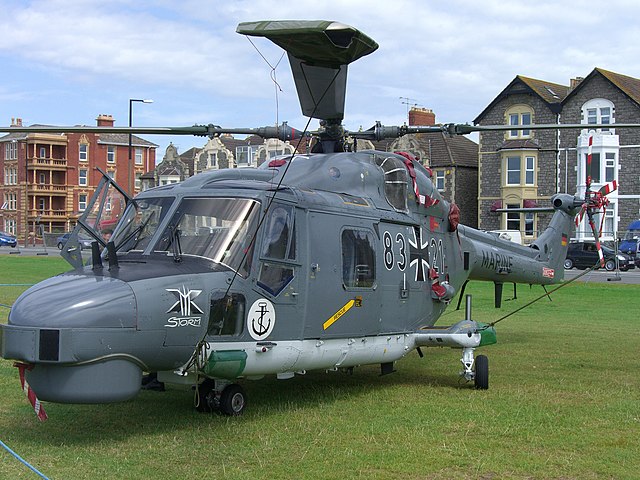
The hangar had space for 2 Sea Lynx Mk.88A helicopters with torpedoes, air-to-surface missiles (Sea Skua) and heavy machine gun. They could also perform transport and SAR mission in addition to ASW and ASUW missions.
⚙ specifications |
|
| Displacement | 3,600 tons (4,490 t full load) |
| Dimensions | 138.85 x 16.7 x 4.35 m (455 ft 7 in x 54 ft 9 in x 14 ft 3 in) |
| Propulsion | CODOG, 2x MTU 20V 956 TB92 diesels, 2x GE LM2500 gas turbines 38 MW |
| Speed | 29 knots (54 km/h; 33 mph) |
| Range | 4,000 nmi (7,400 km; 4,600 mi) at 18 knots (33 km/h; 21 mph) |
| Armament | OTO-Melara 76 mm/62 Mk 75, 2x BK-27 27 mm, Mk 41 Mod 3 VLS Sea Sparrow, 2x Mk 49 RAM, 2×4 Harpoon SSM, 4x 324 mm TTs |
| Sensors | Thales LW08, Thales SMART-S, Thales STIR 180, Raytheon Redpath I, STN Atlas DSQS-23BZ sonar, STN Atlas TASS 6-3 (LFTASS) VDS* |
| Air Group | 2 Sea Lynx with Mk46 Torp. +Sea Skua SSM |
| Crew | 26 officers, 193 enlisted |
Upgrades
Since the summer 2002, the manufacturer of the STIR offered an upgrade with protection against chaff and hit assessment being improved. Also, it was able to track a cross-section of 1 m² at over 140 km, but the displayed range is 60 km. It was not funded and installed unlike Canada and the Netherlands.
The F123 frigates capitalized on the experience with the Bremen class and the abandoned NFR-90 project and Blohm + Voss developed the design on its own volution, expected a replacement for the Hamburg class, creating a new type of ship that took into account all the advantages of the modular MEKO system. These ships looked sleek and modern with their stealthy features, and the most sophisticated and capable warships so far built in Germany. Still, as time passed, they had to go through in the 2009-2011 a new launching device for speedboats, which were also new and from Boomeranger were first tested on the frigate Bayern in 2011 alongside a new marine evacuation system from Viking Life Sea Systems. It was a success and all F123 frigates were upgraded that way.
There was a comprehensive modernization program (“F123 capability adaptation”) planned for the F123 frigates starting in 2014. The the Sea Sparrow surface-to-air missiles being replaced by the ESSM as part of an ammunition exchange and measures taken to improve stability, but canceled for cost reasons and reverted to simpler structural changes. The analogue control of all technical systems were however replaced by a digital one and the light 20 mm Rh 202 guns were replaced by 27 mm light naval guns. “SABRINA 21” became the new command and weapon deployment system, expanding capabilities and the fire control system was replaced. F 216 Schleswig-Holstein was equipped with four MASS decoy launchers (TKWA) from Rheinmetall in December 2006 so all three remaining frigates were also upgrade that way.
From 2010 on, the F123 class were upgraded under the Fähigkeitsanpassung FüWES (FAF) project. This was an overhaul of the combat management system and SABRINA 21, a version of the Thales Nederland TACTICOS system, wasinstalled. This went with an IFF upgrade for the EADS/Hensoldt MSSR 2000 I secondary radar. The LW 08 long-range 2D search radar and its medium-range 3D surveillance radar SMART-S were not included for budgetary reasons.
From 2011, SABRINA 21 became the new command and weapon deployment system, also expanding the capabilities of the system as a whole, with a fire control system comparabvle to the one on the Sachsen-class, also based on Thales TACTICOS, connecting all sensors and effectors via Ethernet and distributed computers as well as multi-purpose consoles wortking on open gateways and with mission-specific software. The system is compatible with commercial software and database management systems, expert systems as well as blackboards and artificial neural networks. Each console store the entire application and could be switched to another task. Programs and computing power could be moved via the network in other stations in case of failures, and functional data is continuously moved automatically for redundancy.
In July 2021, Swedish defense company Saab was awarded a contract to deliver and install the Sea Giraffe 4A instead of the LW 08 radar, Sea Giraffe 1X replacing the SMART-S and the new CEROS 200 Fire Control Radar with the 9LV combat management system and new IFF. work is done at Abeking & Rasmussen, with logistical support by Saab.
Career of the Brandenburg class
 Brandenburg (F215)
Brandenburg (F215)
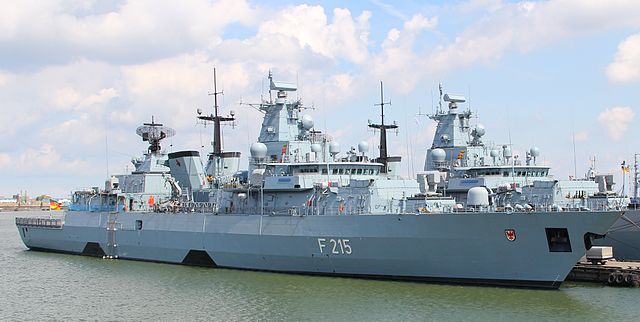
Brandenburg (call sign DRAH) was laid down at Blohm + Voss on 11 February 1992, launched on 28 August 1992 and completed on 14 October 1994. After trials and formal commission she was assigned to 6. Fregattengeschwader. After the fleet was restructures she was assigned to 2. Fregattengeschwader in Wilhelmshaven.
Missing Logs for 1995-2006.
In 2006 she assigned to the United Nations Interim Force in Lebanon as flagship for taskforce commander Flotilla Admiral Andreas Krause. On 30 November 2006 she hosted Foreign Minister Frank-Walter Steinmeier, while she was anchored in Larnaca, Cyprus. In 2009 she was deployed with Operation Atalanta and performed anti-piracy patrols, off the Horn of Africa. On 3 August 2009 Brandenburg managed with Rheinland-Pfalz toreleas from pirates the MV Hansa Stavanger and escorted her into port in Mombasa, Kenya. On 7 September Brandenburg launched a Sea Lynx helicopter for a reconnaissance as a suspect skiff was signalled south of Mukalla, Yemen. Five suspects were observed throwing ladders and weapons overboard and the Frigate caught them, fired warning shots across her bow and after she refused to stop, disabled the skiff with gunfire. A team met them with an inflatable boat, seized weapons and caught the pirates. One was injured with gunfire and was taken in medical care, but died on board. The suspects were later released.
In 2010 Brandenburg, Niedersachsen, supported by the Frankfurt am Main and ammunition transport ship Westerwald took part in a major exercise, Einsatzausbildungsverband (Operational Training Association). Brandenburg also took part in the German-South African missile exercises Good Hope IV. With the same team she also took part in Operation Active Endeavour. By late February 2011 she teamed with the supply ship Berlin and were sent to the Libyan coast, assisting in the evacuation of German citizens (Libyan Civil War). They proceeded to evacuations and transported Egyptian citizens from the port of Gabes in Tunisia to Alexandria.
From March to August 2014 Brandenburg returned for another tour of duty in Operation Atalanta. She was the flagship of the Force Commander, Flotilla Admiral Jürgen Mills.
On 20 March 2017 she left Wilhelmshaven to relieve Sachsen in Standing NATO Maritime Group 2 in Souda, Crete. She became flagship for Flotilla Admiral Axel Deertz. While she left Piraeus on 17 April 2017 however she collided with a pier and damaging her steering gear and propeller. She was tugged back to the floating dock at Paloukia in Salamis Naval Base for repairs until 22 May 2017. On 4 July 2017, Deertz handed command to a British commodore, Brandenburg was no longer flagship in this operation.
Missing logs for 2018-2024.
She is still active, albeit started an overhaul in 2021.
 Schleswig-Holstein (F216)
Schleswig-Holstein (F216)
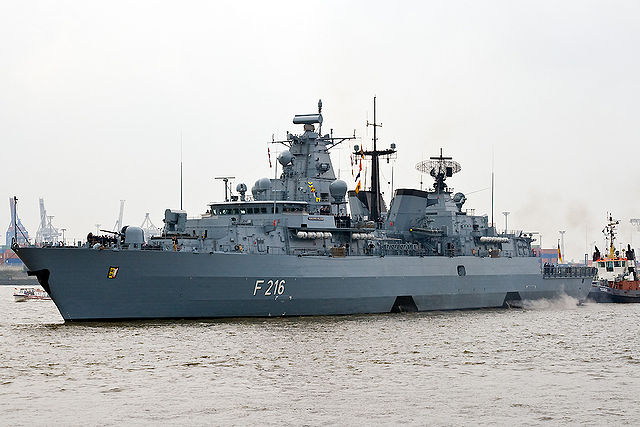
Schleswig-Holstein (call sign DRAI) was laid down on 1 July 1993, launched at Howaldtswerke on 8 June 1994 and completed on 24 November 1995 and assigned to 6. Fregattengeschwader. After reorganisation, she was assigned to 2. Fregattengeschwader at Wilhelmshaven. Missing logs 1995-2008.
She took part in the Maritime Task Force, UN Interim Force deployed in Lebanon from September to December 2009 as flagship under Admiral Jürgen Mannhardt and relieved on 19 May 2010 the frigate Emden at anti-piracy Operation Atalanta (Horn of Africa). She stayed 124 days at sea there, she teamed with the EUNAVFOR flagship De Grasse, escorting ships from the World Food Program and African Union Mission in Somalia until relieved by Köln in September 2010.
From June to December 2014, Schleswig-Holstein worked for the Organisation for the Prohibition of Chemical Weapons when escorting MV Cape Ray (carrying syrian chemical weapons) across the Mediterranean, relieving Augsburg. Next she was deployed on the Cougar 2014 exercises in the Mediterranean and Persian Gulf and escorted the British amphibious combat group center around HMS Ocean, HMS Bulwark and supply ships RFA Lyme Bay and RFA Wave Knight.
From June to November 2015 Schleswig-Holstein worked with EU Navfor Med in the Mediterranean, rescuing migrants from shipwrecks among others. On 22 July she rescued 111. On 24 August a pregnant Somali woman rescued gave birth aboard and the child was named Sophia after the earlyer destroyer radio call sign “Sophie X” and the battleship SMS Schleswig-Holstein dedicated to Princess Louise Sophie of Schleswig-Holstein-Sonderburg-Augustenburg. EUNAVFORMED was renamed “Operation Sophia” afterwards. In total she took part in the rescue of 4,224 shipwrecked refugees until back to Wilhelmshaven on 9 November 2015.
Missing logs 2015-2024.
 Bayern (F217)
Bayern (F217)
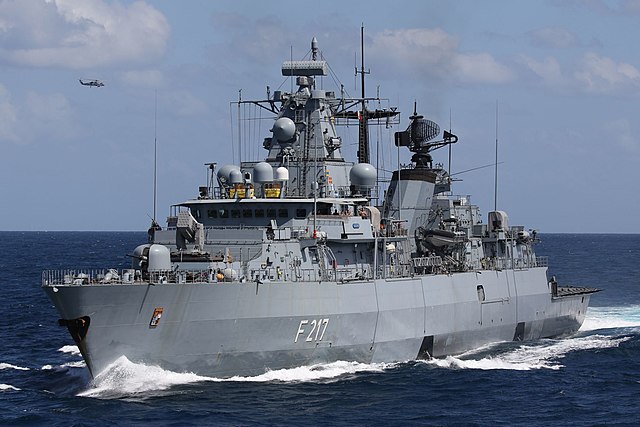
FGS Bayern (Call sign DRAJ) was laid down on 16 December 1993 at Nordseewerke, launched on 30 June 1994 and completed on 15 June 1996. and assigned to 6. Fregattengeschwader. After the naval structure was reorganised, Bayern was assigned to 2. Fregattengeschwader, based at Wilhelmshaven.
Bayern was deployed in the Adriatic in 1999 for Operation Allied Force, the NATO bombing of Yugoslavia. In April-November 2005 she became flagship for Wolfgang Kalähne as CiC, Standing NATO Maritime Group 2, taking part in numerous drills and manoeuvers. Next she took part in support of Operation Active Endeavour. Between September 2007 to March 2008 Bayern became flagship of Hans-Christian Luther (CiC) Maritime Task Force, UN Interim Force, in Lebanon. Late January 2008 saw Bayern assisting the disabled container ship Gevo Victory, sending a distress call off the Lebanese coast, rescuing 14.
On 18 July 2011, Bayern left Wilhelmshaven for a first round of anti-piracy opertions (Operation Atalanta) off the Horn of Africa, arriving on station on 13 August under command of Thomas Jugel with became flagship of the task force. She remained there coordinating deployments until 6 December, and was back at Wilhelmshaven on 22 December 2011. Next she was flagship agains for Thorsten Kähler, commander of Standing NATO Maritime Group 2 until 1 June 2012, and joined exercises and manoeuvres of Operation Active Endeavour. (She patrolled the Mediterranean and monitored shipping to help deter, defend, disrupt and protect against terrorist activity, part of the immediate response to terrorist attacks on 11 September 2001).
Bayern deployed on 26 January 2015, for another tour of duty in Operation Atalanta, remaining on station until back on 3 July 2015. She made a third deployement for Operation Atalanta on 23 March as flagship under Admiral Jan Christian Kaack over five months, making 32,000 nautical miles, and back home on 8 August 2016. On 7 March 2018 she sailed from Wilhelmshaven for Standing NATO Maritime Group 2 this time deployed in the Aegean Sea, and replaced the replenishment ship Frankfurt am Main there. This went on until late August 2018.
In August 2021, Bayern joined the South China Sea trying to show the flag in the Indo-Pacific region and navigate for the first time in the south china sea (but not taiwan strait) in the western freedom of navigation stance. Bayern visited Fremantle for the first time on 28 September 2021 after a long-pre-planned one-week visit (a first since Gorch Fock in 1988 in Sydney). China denied her permission to dock in Shanghai so she remained in Australia and then headed for Darwin from Fremantle. Currently (Dec. 2024) she is moored at Wilhelmshaven for the winter.
 Mecklenburg-Vorpommern (F218)
Mecklenburg-Vorpommern (F218)
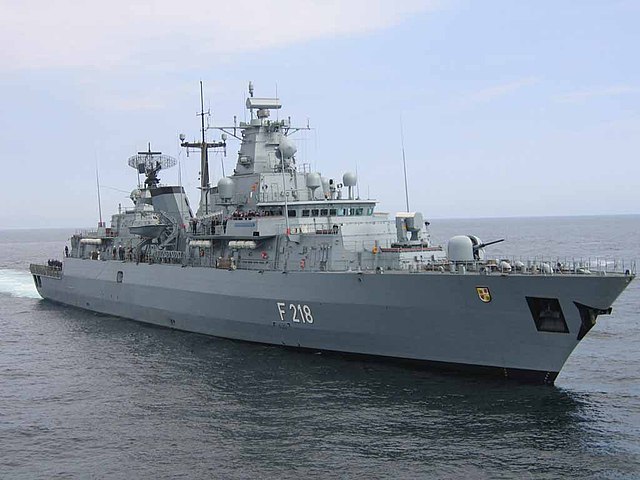
FGS Mecklenburg-Vorpommern (call sign DRAK) was laid down on 23 November 1993 at Bremer Vulkan, launched on 23 February 1995 and completed on 6 December 1996, assigned to 6. Fregattengeschwader. After reorganisation she was reassigned to 2. Fregattengeschwader at Wilhelmshaven.
She was deployed several with NATO’s Standing Naval Force Atlantic (STANAVFORLANT) in 1998 and in 2000. She also took part in Destroyer Exercises DESEX 1999, which included a circumnavigation of South America, DESEX 2002, over five-month in the Med, Souda Bay (Crete) and Indian Ocean, Karachi (Pakistan) or Mormugao, Cochin (India) and Pacific, Manila (Philippines), south China sea (Qingdao, China) or Asia at Inchon (South Korea), Tokyo and back via Suez to Málaga in Spain. While in Tokyo, long tome before a German ship seiled there, she hosted a reception by German President Johannes Rau, for the Japanese imperial couple, Emperor Akihito and Empress Michiko. Underway back home she took part in a missile exercise off Crete. In late 2002 she made another six-month deployment for Operation Enduring Freedom on the Horn of Africa up to 2003.
Mecklenburg-Vorpommern returned for another TOD in Operation Enduring Freedom between November 2004 and April 2005 as flagship for Flotilla Admiral Henning Hoops, Combined Task Force 150. From November 2005 to May 2006 she took part in Standing NATO Maritime Group 1 as flagship for German Commodore Wolfgang Kalahl and an international coordination staff until the end of January 2006. She took part in Operation Active Endeavour again. In 2006 she was flagship for Andreas Krause, CiC Maritime Task Force, supporting the United Nations Interim Force in Lebanon. She then swapped for aniother tour in Operation Enduring Freedom off the Horn of Africa (November 2008 to May 2009). From January to April she was flagship, Combined Task Force 150 under Flotilla Admiral Rainer Brinkmann.
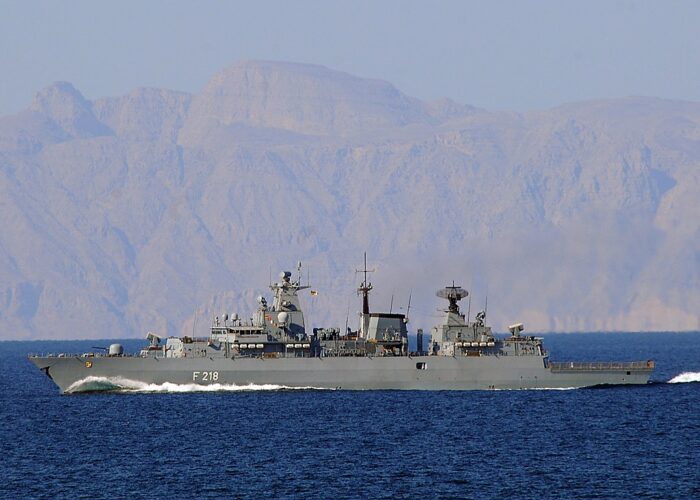
On 28 November 2008, Mecklenburg-Vorpommern sent an helicopter to rescue 3 crew members from the chemical tanker MV Biscaglia. The men jumped overboard during a pirate attack in the Gulf of Aden. Later she helped the cruise ship MS Astor transiting the Gulf of Oman from Sharm-al-Sheikh to Dubai after she detected pirate speedboats going for Astor, manoeuvred into their path and firing warning MG bursts. Passengers never were aware of the situation.
On 11 February 2014 Mecklenburg-Vorpommern sailed with the frigates Hamburg and Augsburg, the corvette Oldenburg, storeship Frankfurt am Main for annual training and exercises which concluded at Kiel on 20 June 2014 followed by manoeuvrers up to Arctic Circle and down to the Equator stopping along the way in 13 ports. By December 2015 she was awarded the flag band of the state of Mecklenburg-Vorpommern by Erwin Sellering in Warnemünde. Her only incident was a collision in the Kiel Canal near Schülp bei Rendsburg on 9 December 2015 with the Cypriot-flagged container ship Nordic Bremen. Her bow was badly damaged and she neeed extensive repairs.
On 16 August 2016, Mecklenburg-Vorpommern departed to take part to the EU Navfor Med mission from mid-September. She returned to Wilhelmshaven on 23 December, while briefly taking part in NATO’s Operation Sea Guardian (maritime security capacity building, support to maritime situational awareness and maritime counter-terrorism).
She was deployed with EU Navfor Med on 7 August 2017 and she visited Augusta, Scicilia to meet on 16 August 2017 the replenishment ship Rhein. Captain Marco Reinisch was succeeded by Christian Schultze. She made several rescue to migrant boats in distress (Operation Sophia) and by 13 September 2017, rescued 134. On 25 October, 158 people, on 2 November, 323 people. A woman from Nigeria gave birth to a boy on board, on 3 November 2017 assisted by the board’s medical team. On 1 November 2017, she was threated by a Libyan patrol boat but Commodore Abdalh Toumia later apologized. After five months she was relieved by the frigate Sachsen by mid-January 2018 and was back in Wilhelmshaven on 26 January 2018 after 29,000 nautical miles covered.
Missing logs, but it seems like her sister she spent the next years in overhaul and modernization (2021-2023).
FGS Mecklenburg-Vorpommern was Flagship since 6 January 2023, under Rear Admiral Thorsten Marx, taking command of SNMG1. Seven months deployed, 151 days at sea, 33,000 miles sailed, back to Wilhelmshaven, on 16 July 23.
As for now, she is in Wilhelmshaven for maintenance and R&R.
Read More/Src
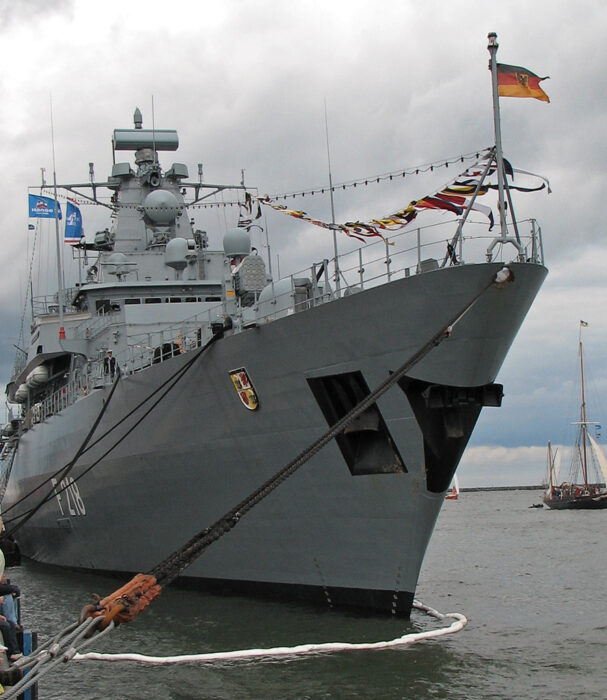
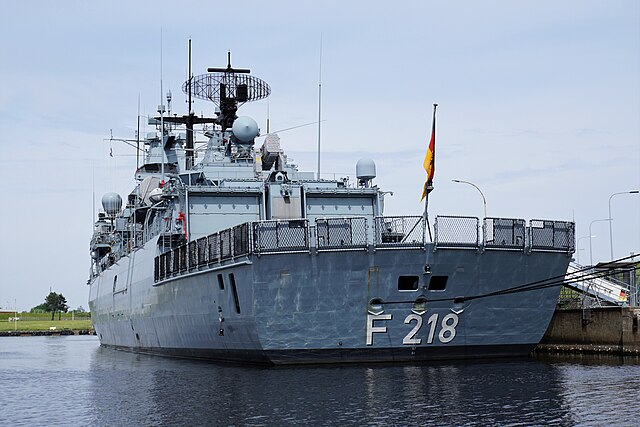
Books
Links
on seaforces.org/
bundeswehr.de/de/organisation/marine
navypedia.org/
on navypedia.org
en.wikipedia.org
de.wikipedia.org/

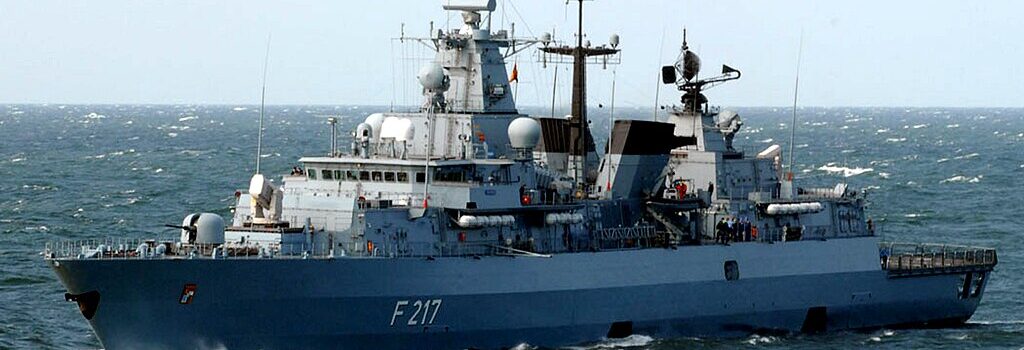


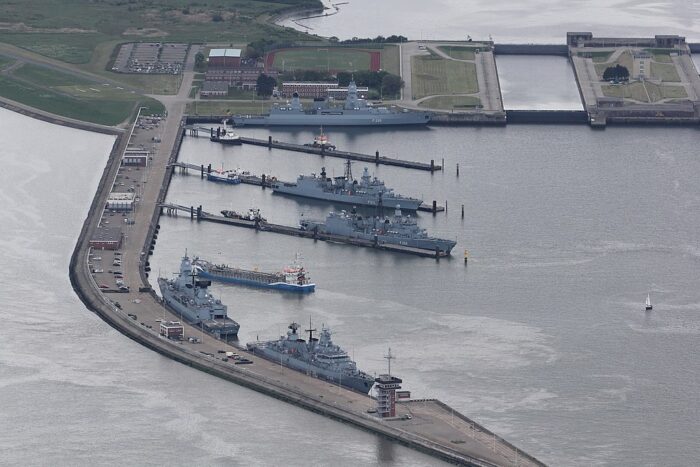
 Latest Facebook Entry -
Latest Facebook Entry -  X(Tweeter) Naval Encyclopedia's deck archive
X(Tweeter) Naval Encyclopedia's deck archive Instagram (@navalencyc)
Instagram (@navalencyc)





 French Navy
French Navy Royal Navy
Royal Navy Russian Navy
Russian Navy Armada Espanola
Armada Espanola Austrian Navy
Austrian Navy K.u.K. Kriegsmarine
K.u.K. Kriegsmarine Dansk Marine
Dansk Marine Nautiko Hellenon
Nautiko Hellenon Koninklije Marine 1870
Koninklije Marine 1870 Marinha do Brasil
Marinha do Brasil Osmanlı Donanması
Osmanlı Donanması Marina Do Peru
Marina Do Peru Marinha do Portugal
Marinha do Portugal Regia Marina 1870
Regia Marina 1870 Nihhon Kaigun 1870
Nihhon Kaigun 1870 Preußische Marine 1870
Preußische Marine 1870 Russkiy Flot 1870
Russkiy Flot 1870 Svenska marinen
Svenska marinen Søværnet
Søværnet Union Navy
Union Navy Confederate Navy
Confederate Navy Armada de Argentina
Armada de Argentina Imperial Chinese Navy
Imperial Chinese Navy Marinha do Portugal
Marinha do Portugal Mexico
Mexico Kaiserliche Marine
Kaiserliche Marine 1898 US Navy
1898 US Navy Sovietskiy Flot
Sovietskiy Flot Royal Canadian Navy
Royal Canadian Navy Royal Australian Navy
Royal Australian Navy RNZN Fleet
RNZN Fleet Chinese Navy 1937
Chinese Navy 1937 Kriegsmarine
Kriegsmarine Chilean Navy
Chilean Navy Danish Navy
Danish Navy Finnish Navy
Finnish Navy Hellenic Navy
Hellenic Navy Polish Navy
Polish Navy Romanian Navy
Romanian Navy Turkish Navy
Turkish Navy Royal Yugoslav Navy
Royal Yugoslav Navy Royal Thai Navy
Royal Thai Navy Minor Navies
Minor Navies Albania
Albania Austria
Austria Belgium
Belgium Columbia
Columbia Costa Rica
Costa Rica Cuba
Cuba Czechoslovakia
Czechoslovakia Dominican Republic
Dominican Republic Haiti
Haiti Hungary
Hungary Honduras
Honduras Estonia
Estonia Iceland
Iceland Eire
Eire Equador
Equador Iran
Iran Iraq
Iraq Latvia
Latvia Liberia
Liberia Lithuania
Lithuania Mandchukuo
Mandchukuo Morocco
Morocco Nicaragua
Nicaragua Persia
Persia San Salvador
San Salvador Sarawak
Sarawak Uruguay
Uruguay Venezuela
Venezuela Zanzibar
Zanzibar Warsaw Pact Navies
Warsaw Pact Navies Bulgaria
Bulgaria Hungary
Hungary

 Bundesmarine
Bundesmarine Dutch Navy
Dutch Navy Hellenic Navy
Hellenic Navy Marina Militare
Marina Militare Yugoslav Navy
Yugoslav Navy Chinese Navy
Chinese Navy Indian Navy
Indian Navy Indonesian Navy
Indonesian Navy JMSDF
JMSDF North Korean Navy
North Korean Navy Pakistani Navy
Pakistani Navy Philippines Navy
Philippines Navy ROKN
ROKN Rep. of Singapore Navy
Rep. of Singapore Navy Taiwanese Navy
Taiwanese Navy IDF Navy
IDF Navy Saudi Navy
Saudi Navy Royal New Zealand Navy
Royal New Zealand Navy Egyptian Navy
Egyptian Navy South African Navy
South African Navy






























 Ukrainian Navy
Ukrainian Navy dbodesign
dbodesign